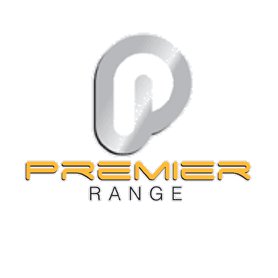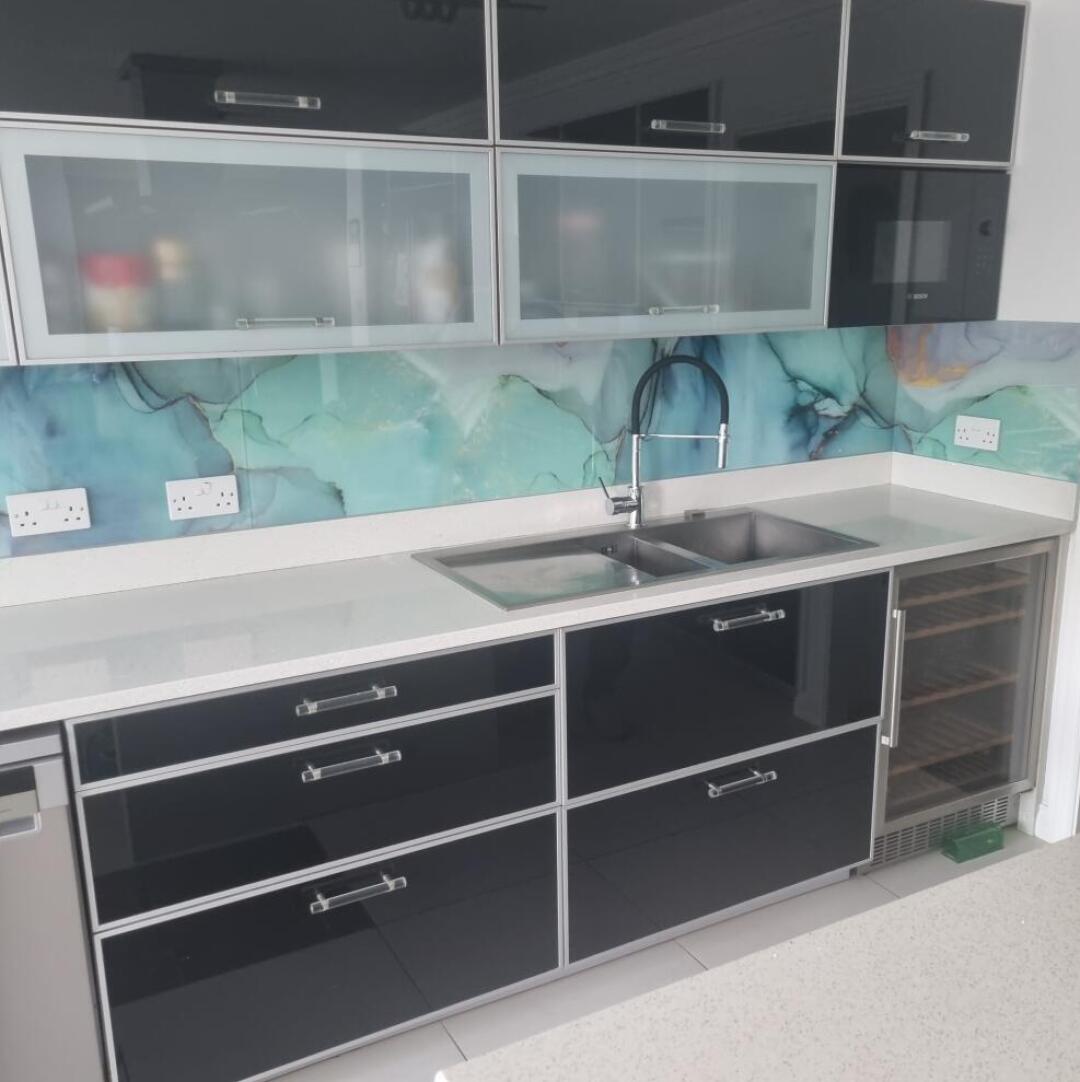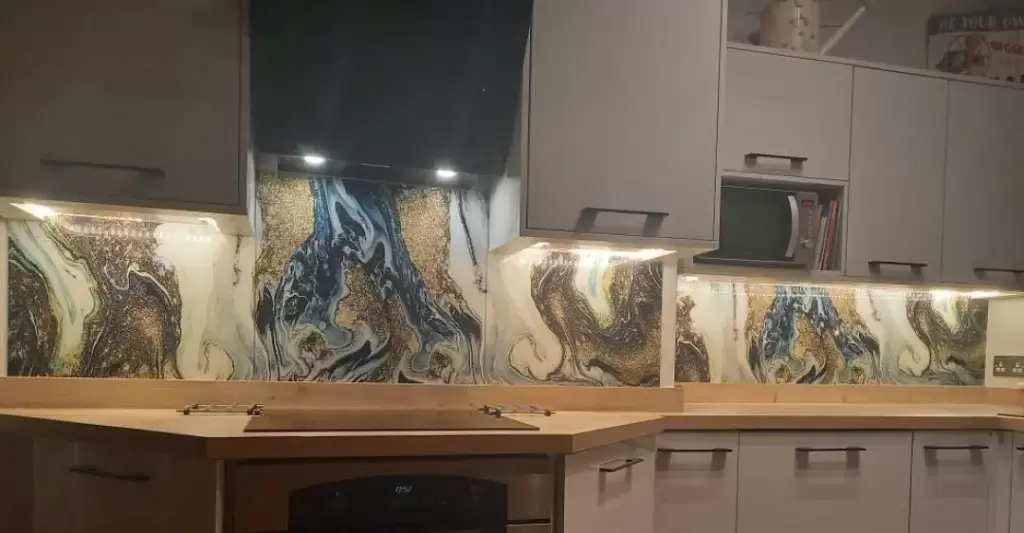
When it comes to sprucing up the kitchen, you can’t go far wrong with an acrylic splashback.
Easy to fit, easy to clean and very durable, they can transform the look of your room with very little effort – plus they are great value for money.
They offer high impact resistance and are more lightweight than their toughened glass counter parts.
So, if you don’t trust the plaster, or you are wanting something easy to hang in an old house, acrylic may be the way to go.
Bright and vibrant colours can be easily added to acrylic, plus, it resists fading so you’ll get a good, long lasting finish.
What is an acrylic splashback?
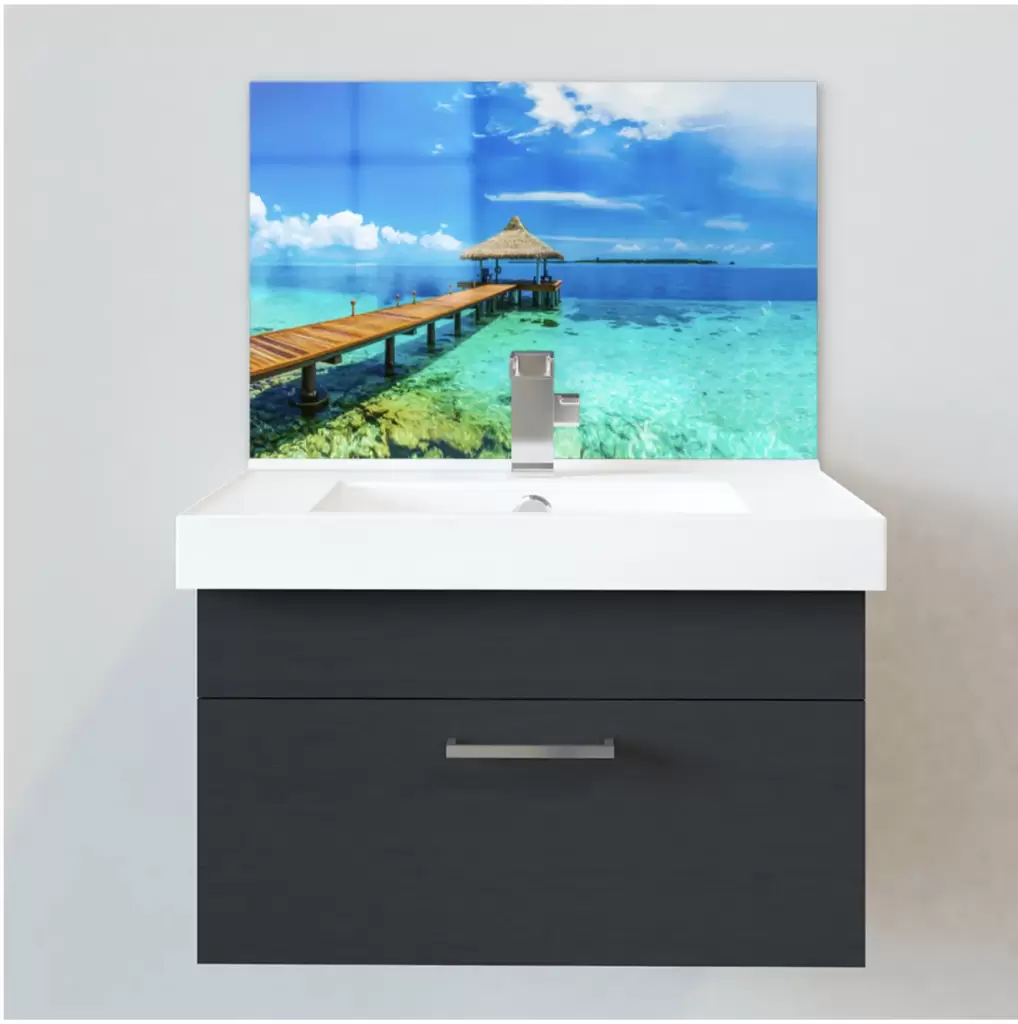
Acrylic is lighter, easier to cut, cost-effective alternative to glass.
As they are a kind of plastic they are very light but also able to withstand heavy impacts. They come in sheets and can cut in any size and shape you need – either by the manufacturer, a qualified technician or, if you a confident, yourself.
Obviously Acrylic is much easier to handle than glass as it’s very much lighter, so fitting options can be much more varied.
You can drill it to create your own fitting, you can glue it, you can use mirror clips, you could even hang your panel like a picture if you wish.
One thing that is worth bearing in mind is, as acrylic is much more flexible than glass, it will follow the contour of your wall.
So, if you are looking to smooth a surface out as part of your kitchen design, it may be better to look at glass or metal.
Or, you could add a sheet of MDF sheet behind the panel, but that would rather defeat the reasons for using acrylic.
What are the benefits of Acrylic?
As with all materials, the benefits really depend on the area you are working in, what other materials you are using and the effect you are looking for in your interior design.
Is it cheaper? If you are just buying acrylic panels then it may be cheaper than. glass but, if you looking at prints or colours, there will be very little difference in price.
So, what does acrylic offer:
Non-shatter
If you think there are certain parts of the kitchen, or bathroom, that are more susceptible to damage, getting knocked or in danger or being attacked by the kids/pets, then acrylic is a safe bet as it won’t shatter.
Toughened safety glass will shatter safely, but then you have to replace it!
Finish
You have the same options for printing on acrylic as you do on glass, though the solid colours are a little more tricky depending on what you want.
Or course, you can also have them plain and paint the area behind them too.
Heaviness
We keep mentioning this but it really is the major advantage over glass.
You can hang the acrylic from any surface or material, within reason. Doors, the family bathroom even the ceiling if you wish!
Is acrylic heat resistant?
No, no it is not.
Well, it is to a certain extent.
The panels aren’t going to suffer if the heating gets a bit carried away, but we wouldn’t recommend putting them behind hobs, above radiators or near an oven.
As a guide, acrylic can deform at temperatures as low as 80 degrees Celsius.
If you need heat protection then you will need to look at 6mm toughened glass panels.
Is acrylic better than glass?
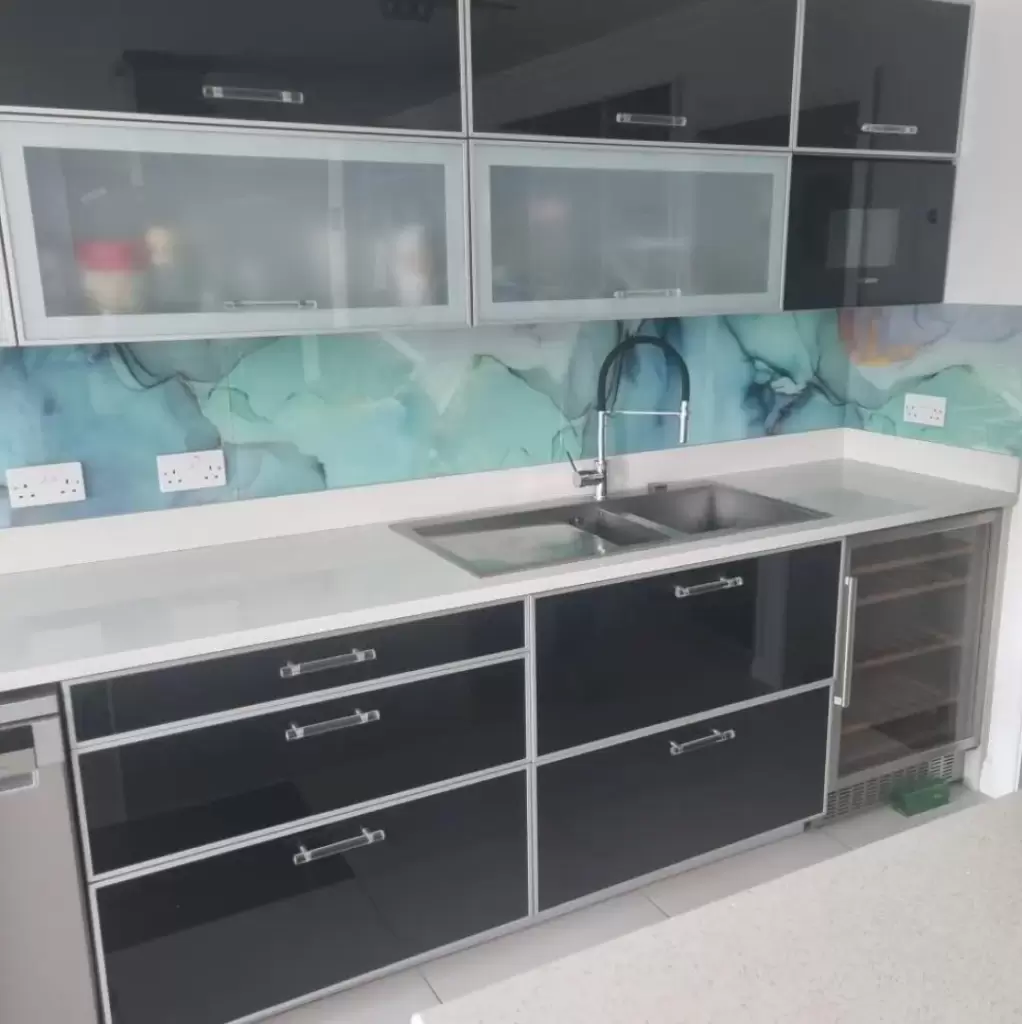
No, both materials are equally good in different circumstances.
As we have said before, research the area in which your panel is being used is the best thing you can do to ensure you have the very best material for the job.
If you are in doubt then speak to an expert either a local fitter or someone at the place you are buying your materials.
So, shall we compare glass and acrylic?
After shop modification
One for the acrylic splashbacks here!
Once a a piece of glass has been toughened it can no longer be easily customised. The process of toughening glass means it will shatter in 1000s of tiny, non-sharp pieces. This will happen if you knock an edge, try to cut it or use a drill to make holes.
So, if you are looking to customise your panel after you get it home, you’re going to need to order acrylic.
Which is stronger?
Glass splashbacks are made of toughened material, which makes them more resistant to high temperatures and impact.
This makes them a safer option to use in the kitchen, as you don’t have to worry as much about what you are cooking.
Price
There is very little difference in price between printed splashbacks whether they are glass or plastic.
Cleaning
Both materials are easy to clean because of their smooth surfaces.
However, acrylic splashbacks don’t attract dust and are easy to wipe with a cloth.
On the negative side, they are prone to scratches and need to be handled with care.
The choice between the two materials depends on your requirements and interests. .
What is acrylic?
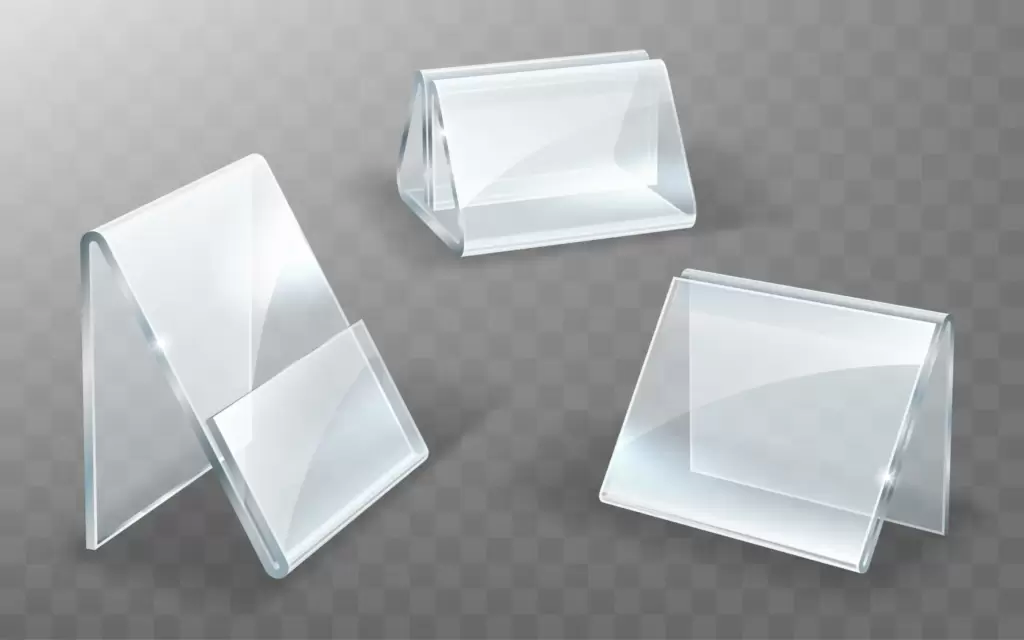
Acrylic material is a form of plastic with high rigidity and is made from a chemical called polymethyl methacrylate, which makes the splashback quality very good.
Its ability to allow ultraviolet radiation to pass guarantees that it does not turn yellow and is commonly used in applications such as making aquarium boxes, visors for helmets, bulletproof screens, and many more.
Installing acrylic splashbacks.
Acrylic is much easier to fit than glass as it’s less fragile and much lighter.
However, we always recommend getting a professional fitter to work on anything like this.
Imagine if you have your dream kitchen but the splashback behind the sink is wonky!
Of course, if you are a bit of a DIY whizz then you should have the tools and skills needed to get the job done right.
Here’s a few tips:
Check the walls
You need to first check the flatness of your wall. If the wall is not smooth, the splashback will not stick to your wall and can drop if the adhesive loosens.
The walls must be cleaned, devoid of any dust or dirt on the surface. Also, the presence of moisture or flaking of plaster needs to be avoided.
Get a professional to repair your wall if there are cracks or breakages.
Check the size
Before installing your splashbacks be sure to remove all electric appliances from the surface on which they will be installed.
To check whether the splashback will fit in the desired area, simply hold it up to the wall and compare its dimensions.
Fixing the acrylic splashbacks
If you are using an adhesive, and always use one guaranteed by the manufacturer, simply apply the glue on the backside of your splashback using regular spots a few inches apart.
Place it on the bottom edge on the worktop, or where you want the bottom to be, then tilt the panel onto the wall and light push on it.
If any adhesive is used out of the edges of the panel just wipe it away with a damp cloth.
You may need to prop the panel up until the adhesive sets.
Of course, you could also avoid glue all together and simply screw the panel to the wall in each corner.
Then slowly push the splashback upwards till it properly fits your wall.
Covering with a sealant.
Once you are sure the panel is secure, and the adhesive has ‘gone off’ or hardened, then it’s a good idea to seal the edges all the way round using a clear sealant.
This ensures that condensation and dust doesn’t get behind the panel and start to discolour the print or cause any other problems.
Keeping your acrylic clean.
To clean your acrylic splashback, simply use a damp cloth dipped in soap or a cleaning agent.
Be sure to use a soft material, as acrylic splashbacks are prone to scratches.
You can test the cloth on a sample before using it, just to be safe.
So, where do I get a great Acrylic Splashback?
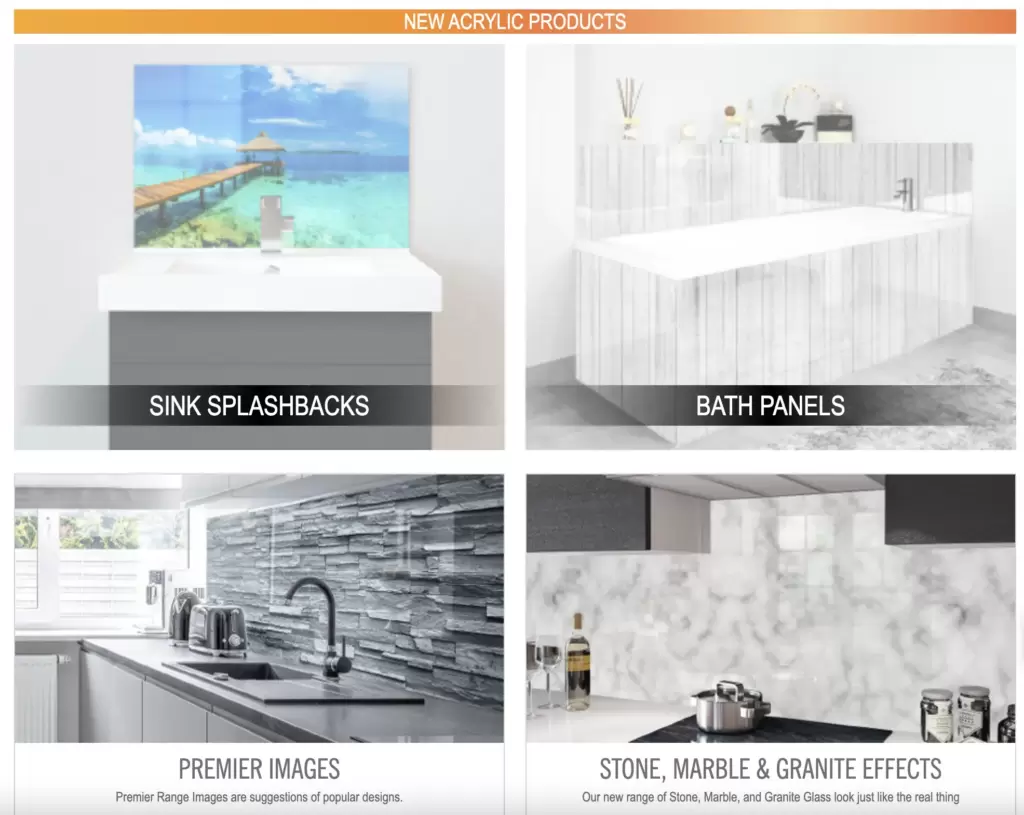
When it comes to service, quality and choice you are gonna have to go a fair way to beat Premier Range.
We’ve been manufacturing Splashbacks and glass accessories for the home and office for around 20 years, and there’s many reasons why we’ve developed a reputation for delivering exceptional Quality Splashbacks at the lowest prices. Prices so low, we offer our infamous Premier Price promise that not only means if you can find the same product elsewhere for less, we’ll match it, but also, if you buy from us, THEN find it cheaper, we’ll even refund the difference to give you that optimum peace of mind*.
